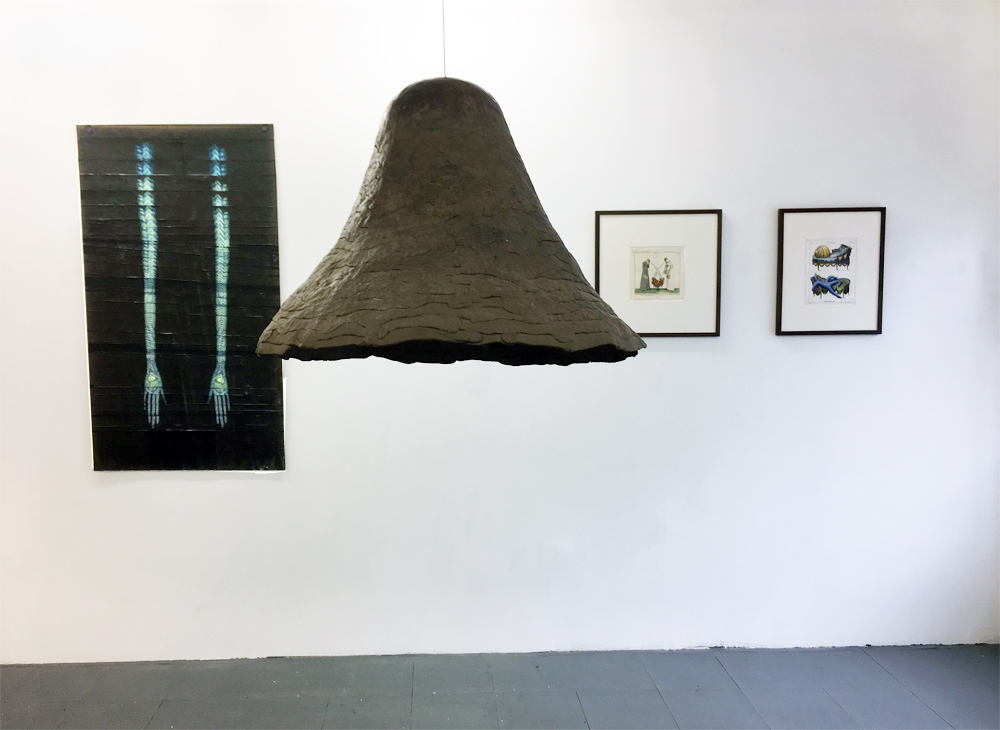Nightjar
press release
Underdonk is pleased to present Nightjar
Opening Friday, May 12 7-9pm
May 12 – June 18
Saturdays and Sundays 1-6pm and by appointment
Closed Memorial Day Weekend May 27 & 28
“At last we saw water gleaming at a distance, and came to a clear tarn, lined with brown leaves and holding a fair picture in its bosom…what a place for summer, and how one envies the frogs!”
– Una Hawthorne [1]
Underdonk is pleased to present Nightjar, a show of five artists engaging human relationships to nature and animals. This relationship is rapidly changing as the ecosystem becomes increasingly hostile and threatening to both humans and animals. This show explores the conceptual, spiritual, personal and investigative ways in which we can relate to the organic, natural world around us.
Sharon Core plants and grows the subjects of her photographs with her own hands. Having created a geodesic dome at her upstate studio, she explores the function and effect that long durational time can have on works of art. Planting, choosing and framing the contents of each photograph, Core is like a scientist as she moves all the way through form, even before it’s inception. The resulting photographs embody both the literal “sottobosco” of the floral bed and it’s ecosystem and references the 17th century Sottobosco painting genre (as in the work of Dutch painter Otto Marseus van Schriek). Core’s photographs evoke a possessed, spatial presence in the woods, while a marginal world sets the stage for the darkening, deepening forest, out of which slowly emerges an awareness of the delicate microworld of the forest bed.
Valerie Hammond‘s traces lie somewhere between the spirit world and the human world – perhaps even a decomposition. Beginning by tracing the arms and bodies of her friends and relations, Hammond visualizes what transmutations of organic forms might lie inside the human outline. Filling this outline with a floral and infernal essence, flowers and fruit become wounds and ferns are skeletal in Hammond’s figures, imagining the slipping away of the human into a primeval space that might be of the land or the sea.
As a tattoo artist in New York in the 1970s and 80s and an illustrator for many years, Ruth Marten understands the power of images. Her works on paper unravel symbols and historical settings into new, mysterious narratives that change the power relationships between humans and animals. Awakening curious narratives in the 18th and 19th century prints she overdraws, Marten unearths something provocative from known historical contexts: surreal worlds where animals can have as much stature, emphasis and power as humans, and sometimes even more.
Priscilla Fusco‘s sculptures engage microfauna from an investigative, cautionary position. The eponymous Grunter, a clay bell hung from the ceiling, emits a low-frequency warning or alarm sound, bringing our attention to a small and humble life form: the worm. “Worm charming” is used to draw worms up out of the ground in a process that mimics the worm’s natural predator, the mole. This sounding is used to collect worms for bait and also as a competitive sport around the world. Fusco’s work highlights our own strange symbiotic effects on other creatures’ ecosystems, letting us become aware of the call of the predator and the human attempt to mimic it. Nearby, the charred baseball bat signifies another kind of human-made alarm (ringing the bell) and a prophetic artifact of a ruined world.
With her raku-fired “Little Ghosts,” Deborah Masters conjures up the spirits of animals. Evocative of altarpieces or devotional objects, these figures intimate aspects of Masters’ personal relationships with and attachment to animals. One can feel the memory imbued in Masters’ hands as borne out by the textures and definition of the figures in the sculpted animal’s face. Their satin dresses mark their wraith-like detachment from the living world. As if attempting to reverse the dying process, they honor the deep connection that can exist between animals and humans.
Like seventeenth century botanist and naturalist Maria Sybilla Merian, recently recognized for her important contributions to biology and entomology, these artists show an urgent sense of uncovering, discovery, growth and attachment to the natural world, engaging both an analytical mind and a sensitivity that is finely honed through the experience of working with one’s hands. Through ornament and adornment, transmutation and material exploration, these artists find ways of building structures and then using those structures to look further into the nature of their subjects. What emerges is a careful, long-form attention to the minute, small scale flora and fauna that subtly surround us and the animals we live with and invite into our lives. These artists lead us through the garden, sometimes in its darkest and strangest parts, whispering that we shouldn’t be afraid, but to stand up – or kneel down – and look.
-Ashley Garrett, May 2017
